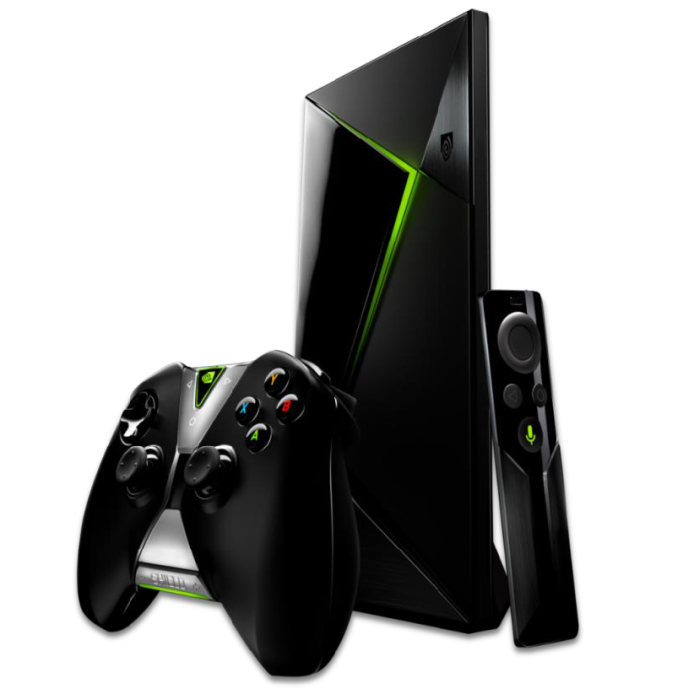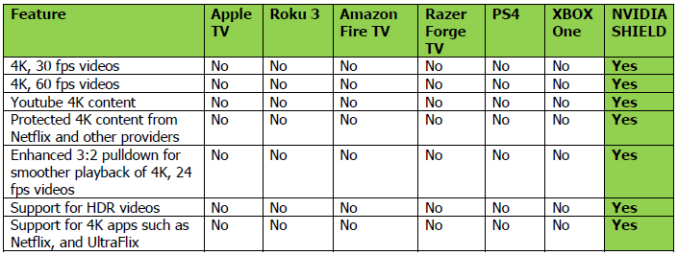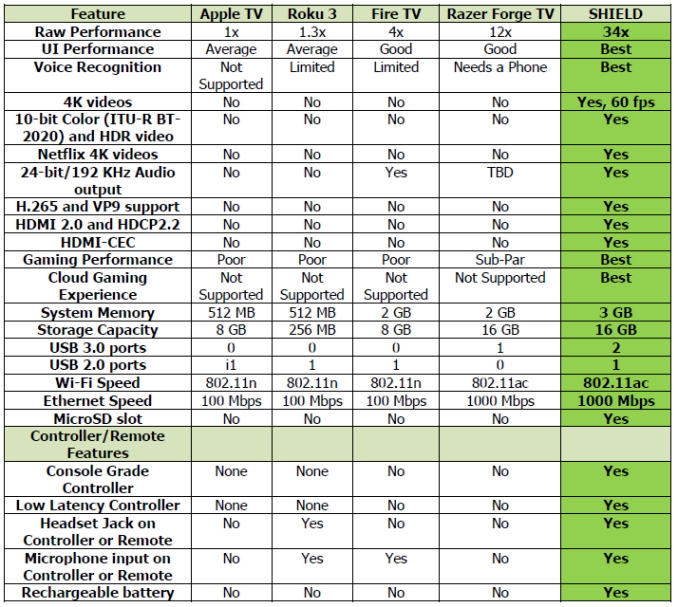The NVIDIA SHIELD Android TV Review: A Premium 4K Set Top Box
by Ganesh T S on May 28, 2015 3:00 PM EST- Posted in
- Media Streamer
- Home Theater
- TV
- 4K
- Shield
- NVIDIA

The battle for the living room (i.e, controlling the television experience) is heating up with forays from multiple vendors. As the cord-cutting trend gains momentum, the time seems to be right for disruption. Roku has been around for a long time and they continue to taste success with inexpensive and small over-the-top set-top boxes (OTT STBs). At the other end of the spectrum is the Apple TV, which, despite just being a 'hobby', has managed to move millions of units. Google had tried to make inroads into this market a few years back with the Google TV / Logitech Revue, but, it unfortunately didn't pan out as expected. Chromecast turned out to be more popular in their second attempt, but it was a limited play. In late 2014, Google launched Android TV along with the Nexus Player.
Coinciding with Google I/O, NVIDIA is releasing their previously announced SHIELD Android TV. First announed back in March at the 2015 Game Developers Conference, SHIELD Android TV is a premium 4K-capable over-the-top set-top box (OTT STB) with a powerful graphics engine. The differentiating aspects compared to the Intel Bay Trail-based Nexus Player and the Qualcomm Snapdragon-based Razer Forge TV lie in 4K support (HDMI 2.0 / HDCP 2.2 / Netflix 4K-certification) and excellent gaming credentials.
| NVIDIA SHIELD Family | ||
| NVIDIA SHIELD Tablet | NVIDIA SHIELD Android TV | |
| SoC | Tegra K1 (2.2 GHz 4x Cortex A15r3, Kepler 1 SMX GPU) | Tegra X1 (4x Cortex A57 + 4x Cortex A53, Maxwell 2 SMM GPU) |
| RAM | 2 GB LPDDR3-1866 | 3 GB LPDDR4-3200 |
| NAND | 16/32GB NAND + microSD | 16GB NAND + microSD + USB |
| Display | 8” 1920x1200 IPS LCD | N/A, HDMI 2.0 4Kp60 Output |
| Dimensions | 221 x 126 x 9.2mm, 390 grams | 210 x 130 x 25mm, 654 grams |
| Camera | 5MP rear camera, 1.4 µm pixels, 1/4" CMOS size. 5MP FFC | N/A |
| Battery | 5197 mAh, 3.8V chemistry (19.75 Whr) | N/A, 40W Power Adapter |
| OS | Android 5.0.1 | Android TV |
| Connectivity | 2x2 802.11a/b/g/n + BT 4.0, USB2.0, GPS/GLONASS, mini HDMI 1.4a | 2x2 802.11a/b/g/n/ac + BT 4.1/BLE, USB 3.0 + 2.0, HDMI 2.0 + HDCP 2.2, IR Receiver, Gigabit Ethernet |
| Launch Price | $299 (16GB/WiFi) + $59 (optional controller) | Basic: $199, Includes 1 SHIELD Controller Pro: $299, Adds 500GB Hard Drive |
The NVIDIA SHIELD smart TV platform comprises of three distinct products, the SHIELD console, the SHIELD wireless controller and the SHIELD remote.
The SHIELD is the main console, integrating a Tegra X1 SoC along with 3 GB of LPDDR4 DRAM and 16 GB of storage. I/O ports include two full-sized USB 3.0 host ports, a USB 2.0 micro-USB device port, GbE RJ-45 port, IR for universal remotes and 802.11ac 2x2 MIMO Wi-Fi with Bluetooth 2.1. It also includes a microSDXC slot. Video output is handled by a HDMI 2.0 port with HDCP 2.2 support.
The SHIELD Wireless Controller is the game controller bundled with the SHIELD console, and was first launched last year with the SHIELD Tablet. It uses Wi-Fi Direct for communication. A stereo headset jack and microphone are integrated. It also includes a rechargeable battery that can provide up to 40 hours of battery life.
Finally, the SHIELD Remote It is meant to be a replacement for the game controller in situations where single-handed operation is preferable. It uses Bluetooth for communication with the console. Like the game controller, a microphone and headset jack are included. The rechargeable battery is good for up to 4 weeks.
While the game controller and the console together retail in the basic package for $199, the SHIELD Remote is available separately for $50. Meanwhile after a slight snafu where it was announced back in April and then immediately pulled, NVIDIA is indeed offering a higher-end Pro SKU. SHIELD Pro model is similar to the SHIELD described above, except it adds an internal 500 GB hard drive into the mix and bundles a game - Borderlands: The Pre-Sequel! The Pro model is priced at $299.
Prior to diving into the details, let us take a look at the devices that NVIDIA is positioning the SHIELD Android TV against. Note that the two tables below are direct from NVIDIA's marketing material.
As we will see further down in the review, the above table is not far from the truth. In fact, except for NVIDIA claiming that their pulldown algorithm is enhanced compared to the competition, we tend to agree with everything. For the moment at least, NVIDIA pretty much has the 4K set top box to themselves.
NVIDIA claims a 34x raw performance increase compared to other OTT STB platforms. We won't endorse that particular number, but, in general, the performance of the SHIELD is miles ahead of the competition. The only other entry we find contentious is the availability of 24-bit / 192 KHz audio output. As we will see in the local media playback evaluation section, this is something of a moot point in most scenarios since the unit doesn't have licenses for decoding lossless HD audio. In any case, the above tables give an idea of where NVIDIA is positioning the SHIELD Android TV in the market.
The NVIDIA SHIELD Android TV also happens to be the first shipping product with the Tegra X1 SoC. We will first analyze the SoC and its performance in detail before moving on to Android TV in general and the SHIELD in particular.













167 Comments
View All Comments
spinportal - Thursday, May 28, 2015 - link
What is interesting is comparing to the Intel NUCs for a media center hub (or HP Stream Mini) with Windows 10. The CPU power is close to the Intel Celeron 2957U, where a i5-5250U (NUC5i5YH/R) is 50% faster, but the Intel HD graphics is probably 20% slower. Both are fighting for the 4K home theater crowd, but Shield TV is cheaper (barebone NUC is 399 extra SDRAM & mSATA & remote/controller) and baked in 10' UI/UX and easier to maintain for the average user with support for DVR in the future and GRID gaming. Sure Win 10 will have a 10' UI and you can install whatever you want on it to customize to your own content, but higher price to entry and more time needed to tweak. The Intel Stick is cute at $150, but falls short in competition for the checklist of features. If sideloading is easy on the Shield TV, tweakers can rejoice and hope apps will scale properly. If people have an XB1 and enjoy the media apps / services and voice activation, then it's a hard sell. Gamestream is just icing, helping the portability of the Shield TV in a remote location (at home most games would have a big enough screen connected and avoid input lag). It's not a Roku or a Chromecast, so to get customers to make a premium purchase like this, targeting 4K video is the bait.nathanddrews - Thursday, May 28, 2015 - link
"This also means that the SHIELD Android TV will not be doing any HD audio bitstreaming"Stopped reading.
Sivar - Thursday, May 28, 2015 - link
``Consumers need to get their expectations right - the SHIELD Android TV needs consideration only if OTT streaming (4K Netflix, in particular) and gaming credentials are important.''The key feature I need is HEVC compatibility. I have many Blu-rays that I encode with FLAC audio, but with my FireTV, I am unable to use HEVC.
Are you saying that the Shield Android-TV is a poor choice for my requirements?
ganeshts - Thursday, May 28, 2015 - link
If you are savvy enough to encode your Blu-rays with HEVC, then I am sure you understand what I am trying to convey..The typical media library also includes TV programs that are interlaced MPEG-2 (for example). The SHIELD is currently not a good solution for such a case.
I have outlined clearly what works and what doesn't. In your case, I would still suggest waiting for a proper HTPC with HDMI 2.0 / HEVC support unless HEVC-encoded Blu-ray rips are the only media files you plan to play in your setup.
TheJian - Friday, May 29, 2015 - link
Being savvy enough to check a few boxes doesn't mean you know everything about formats. You can muddle through handbrake without doing much more than selecting a profile for your device. The person states they are wanting FLAC+HEVC yet you tell him wait for HTPC. HE was clear in what he needed, so you should just say yes it plays what you need, or no it doesn't instead of a flippant response :( He likely has other players for other formats already hence his main feature desired is what he inquired about.But still you're acting as if mpeg2 interlaced is all anyone wants and a reason to NOT buy it, when I'd suggest it's not many people (that can’t get that some other way until this unit CAN do it, like a dvd player or bluray player in your rack already) and most would want all the other stuff this thing can play NOT just bluray HEVC encoded stuff. IE, anything in mkv/mp4 with dolby etc in h264/x264 (which is most libraries of current content and mostly what people rip bluray to also as you even note in the review). This thing plays a LOT more than hevc. IF you're only going to use the NATIVE Android Tv player then it's somewhat limited, but you're not stuck with that and can choose a dozen or more others (paid or free). 3rd party stuff can easily be had to get around it all if not now then at some point most likely. IE you mention kodi can play mpeg2 without license in software. You also mention Deinterlacing might be added soon to Kodi. So your problem with the device here just a software fix away anyway (and only the interlaced part is a problem correct?)? There are many free apps that can deinterlace already on PC for conversion even if players that do it on android don’t exist…but wait for it…
Just check googleplay store: BSplayer, MX player Pro, KMplayer, vlc, etc (not saying which does the job just noting a bunch):
https://www.youtube.com/watch?v=HSBG13gknoA
1080i mpeg 2 on mxplayer without transcoding. Appears this would solve your combo problem, and this is really old version of the software from 2013 post running on nexus 2013. I’m thinking your excuse for not buying is dead already. You can use de-interlacing option in MX player > settings > decoder. Considering you MENTIONED MX Player in your review, you can’t be this ignorant right or am I missing something? Unlike the OP who may NOT know about all this stuff, you definitely DO know about MX player yet seem to be unable to pass the chance to find some reason to KNOCK an nvidia product even when you know what I just showed fixes it. Typical Anandtech BIAS against Nvidia stuff (**cough AMD portal cough**) here or what?
From your last sentence it almost seems as you're acting like HEVC encoded blurays is all it does, which is categorically false (even though that is what the guy said he wanted to play as a main feature).
Worse you even state most people do the following (which it plays fine):
"The SHIELD Android TV / Kodi combination has absolutely no trouble with the vanilla H.264 files that people usually rip their Blu-rays to."
But no ignore that, it doesn't play mpeg2 interlaced stuff (yet, at least out of the box, but seems to with at least mxplayer as shown which you know about) so it sucks...LOL. OK...Whatever. With 100million-500million installs I think most know about this app (free with ads, $6 without) yet you avoid using it for testing. 2.8million reviews too...LOL. That has to be one of the MOST KNOWN apps on android as most use videos on mobile. How well it works on a TV who knows (10 foot interface? Not sure) but that isn't the point. Worst case you just use it for specific vids with issues. .ts files play fine on mx player also. It seems to have many multiples of the installs of kodi (or xbmc if you like). Kodi on the other hand is only available to the handful of people that can find it (not directly on googleplay so to speak).
http://www.androidpolice.com/2015/04/03/kodi-forme...
You can follow how to get to it above I guess if desired (from googleplay & not sideloaded). Maybe this will help it gain popularity ;)
http://forum.kodi.tv/showthread.php?tid=160720&...
Instructions here too I guess.
MX Player features (among other stuff):
"Plays almost every movie files including .3gp .avi .divx .f4v .flv .mkv .mp4 .mpeg .mov .vob .wmv .webm .xvid and many more."
Either I'm missing something here, or don't really get the complaints you're making nor your flippant response to the OP. Are you saying MX Player with deinterlacing checked won't work for mpeg2 as shown in the supplied youtube video? That guy is testing 1080i mpeg2 on it. I'm confused.
Adding-Color - Thursday, May 28, 2015 - link
My ibothsion is that it will play hevc/h.265 content with hardware acceleration and flac should have no licensing issues and doesn't need hardware acceleration, software acceleration should very well be possible on such a beefy SOC. I don't know if there's yet a software avaible that combines both though.Adding-Color - Thursday, May 28, 2015 - link
My impression ...Aegrum - Thursday, May 28, 2015 - link
Perhaps I missed it, but to me the killer feature is streaming my steam library to my TV from my GTX 680 desktop. Why didn't you cover that? I couldn't care less about the android games. Being able to plop down on my couch and stream Witcher 3 from my PC is worth the price of admission, as it nullifies any desire for a steambox, if it works well.jjj - Thursday, May 28, 2015 - link
The 50$ Sream Link should do that in a few months. If it works well enough , getting this just for that feature is excessive.Aegrum - Friday, May 29, 2015 - link
Sadly that price doesn't include the Steam controller, which is likely to be at least $50. I'm also in need of a streaming device for the television, so while yes, a steam link + controller + chromecast would be ~$135, I think the extra capabilities of this device for $200 is a fair price. Plus it's 4K ready for once I get a 4K TV, and all on one HDMI input that I don't have to switch between. And plays more than just what I have in Steam, though unconfirmed whether Steam link will play non-steam titles or not.I like the Steam link, especially for the price, but for me I think the Shield console is a better fit.